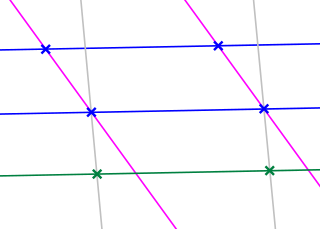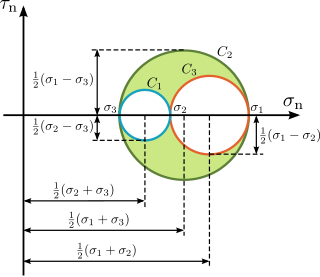Sketch of the method
The following is an informal description of the method found by von Neumann. Assume that we have a free group H of area-preserving linear transformations generated by two transformations, σ and τ, which are not far from the identity element. Being a free group means that all its elements can be expressed uniquely in the form for some n, where the s and s are all non-zero integers, except possibly the first and the last . We can divide this group into two parts: those that start on the left with σ to some non-zero power (we call this set A) and those that start with τ to some power (that is, is zero—we call this set B, and it includes the identity).
If we operate on any point in Euclidean 2-space by the various elements of H we get what is called the orbit of that point. All the points in the plane can thus be classed into orbits, of which there are an infinite number with the cardinality of the continuum. Using the axiom of choice, we can choose one point from each orbit and call the set of these points M. We exclude the origin, which is a fixed point in H. If we then operate on M by all the elements of H, we generate each point of the plane (except the origin) exactly once. If we operate on M by all the elements of A or of B, we get two disjoint sets whose union is all points but the origin.
Now we take some figure such as the unit square or the unit disk. We then choose another figure totally inside it, such as a smaller square, centred at the origin. We can cover the big figure with several copies of the small figure, albeit with some points covered by two or more copies. We can then assign each point of the big figure to one of the copies of the small figure. Let us call the sets corresponding to each copy . We shall now make a one-to-one mapping of each point in the big figure to a point in its interior, using only area-preserving transformations. We take the points belonging to and translate them so that the centre of the square is at the origin. We then take those points in it which are in the set A defined above and operate on them by the area-preserving operation σ τ. This puts them into set B. We then take the points belonging to B and operate on them with σ2. They will now still be in B, but the set of these points will be disjoint from the previous set. We proceed in this manner, using σ3τ on the A points from C2 (after centring it) and σ4 on its B points, and so on. In this way, we have mapped all points from the big figure (except some fixed points) in a one-to-one manner to B type points not too far from the centre, and within the big figure. We can then make a second mapping to A type points.
At this point we can apply the method of the Cantor-Bernstein-Schroeder theorem. This theorem tells us that if we have an injection from set D to set E (such as from the big figure to the A type points in it), and an injection from E to D (such as the identity mapping from the A type points in the figure to themselves), then there is a one-to-one correspondence between D and E. In other words, having a mapping from the big figure to a subset of the A points in it, we can make a mapping (a bijection) from the big figure to all the A points in it. (In some regions points are mapped to themselves, in others they are mapped using the mapping described in the previous paragraph.) Likewise we can make a mapping from the big figure to all the B points in it. So looking at this the other way round, we can separate the figure into its A and B points, and then map each of these back into the whole figure (that is, containing both kinds of points)!
This sketch glosses over some things, such as how to handle fixed points. It turns out that more mappings and more sets are necessary to work around this.













